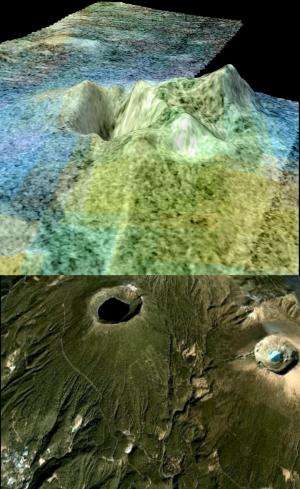Changes in Titan's surface brightness point to cryovolcanism

Changes in surface brightness on Titan observed over four years by NASA's Cassini spacecraft have added to evidence that cryovolcanism is active on Saturn's largest Moon. Anezina Solomonidou has presented results at the European Planetary Science Congress (EPSC) 2013 in London. The authors compared many volcanic-like features, such as flows, calderas and craters, with similar geological features found on the Earth to study the possibility of cryovolcanic activity within regions observed close to Titan's equator.
Titan has an atmosphere rich in organic carbon-based compounds and astronomers believe that beneath its icy surface there is an ocean of liquid water, possibly mixed with ammonia. The low number of impact craters seen on Titan suggests that the surface is relatively young and is therefore dynamic and active. Titan has clouds and rains of liquid methane that mimic Earth's water cycle. Its landscape is remarkably Earth-like with dunes and lakes, erosion due to weathering and tectonic-like features.
"All of these features, plus a need for a methane reservoir and volcanic activity to replenish the methane in the atmosphere, is compatible with the theory of active cryovolcanism on Titan," explained Solomonidou, of the Observatoire de Paris and National and Kapodistrian University of Athens.
Solomonidou and colleagues investigated the potentially cryogenic regions of Tui Regio, Hotei Regio and Sotra Patera using Cassini's Visual and Infrared Mapping Spectrometer (VIMS).
"We were able to penetrate the atmosphere with VIMS and view any changes in these surface features. Interestingly, the albedo (brightness) of two of the areas has changed with time," explained Solomonidou. "Tui Regio got darker from 2005 to 2009 and Sotra Patera—the most favourable cryovolcanic candidate on Titan—got brighter between 2005 and 2006."
Surface variations, together with spectral albedo properties and the presence of volcanic-like features, suggest that these cryovolcanic candidate regions are connected to Titan's deep liquid ocean.
"These results have important implications for Titan's potential to support life as these cryovolcanic areas might contain environments that could harbour conditions favourable for life," said Solomonidou.
Provided by European Planetary Science Congress




















